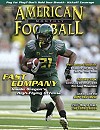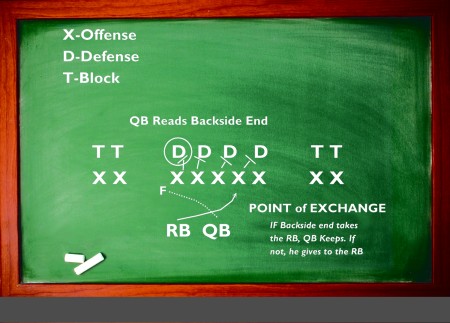Article CategoriesAFM Magazine
|
Flying Ducks – Oregon’s Prolific Fast-Paced Offense Presents Monumental Challenges to Defenses© More from this issueBy Bjorn Zetterberg and David Purdum When former Oregon Head Coach Mike Bellotti hired Gary Crowton as offensive coordinator in 2005 to install the spread option offense, it was his intent to keep up with so many other teams in college football that had gone in that direction. In its first year, the Ducks’ spread yielded impressive results – a 10-2 record, 34.5 points per game and over 430 yards per game in offensive production. Impressive numbers, for sure. But they’re dwarfed by this year’s version of the Oregon juggernaut. In achieving a 12-0 record and a date in the BCS Championship game, Head Coach Chip Kelly’s Ducks lead the FBS in scoring with an eye-popping 49.3 points per game. They are in a virtual tie with 537.5 total yards per game and their 303.8 yards rushing per game trails only several teams that rely almost exclusively on the run. What truly sets the team apart, however, from other high-powered offenses, is the pace at which they operate. Don’t blink, they’ll be gone. Need a breather for your defense late in the game? Forget it. Think you can control the Ducks by limiting their time-of-possession? Think again. Week after week, they’ve steamrolled opponents with a lightning-quick offense that emphasizes the run and keeps defenses off-balance by calling and running plays faster than anyone. In short, Oregon is on the doorstep of a national championship because of a record-setting, “Run First” spread option offense that operates at warp speed. Having the nation’s leading rusher in LaMichael James certainly has helped. But it’s the Oregon offensive play calling, combined with an up-tempo, no-huddle approach that they have perfected that has had defensive coordinators losing sleep and defenses gasping for breath all season. According to second-year Offensive Coordinator Mark Helfrich, the three hallmarks of Oregon Football are, “Play fast, play hard and finish.” It starts in practice and that, says Helfrich, is what differentiates the two-time defending Pac 10 Champion Ducks from other programs. “If you want to say something’s different about this team compared to other teams I’ve been part of, it’s been our practices. Our practices are awesome,” said Helfrich. “This is the best practice team that I’ve ever been around in terms of their enthusiasm, intensity, tempo, competition and attention to detail every day, every single day.” It’s those practices, run at full-speed with multiple play reps, that prepare players for the intense pace that Oregon employs during games. This season, the Ducks averaged less than 24 seconds between downs and sometimes cut that down to under ten seconds when in sync. It’s a regular occurrence to see scoring drives that last under a minute. Running Backs Coach Gary Campbell, who, in his 28th year at Oregon is the longest-tenured assistant in the FBS, knows the effect that this breakneck speed has on defenses. If they are under-prepared or under-conditioned, they will be exposed, and fast. “It’s unusual in that you don’t see it very often and it requires a different type of preparation – preparation and pace that most teams aren’t fully ready for,” said Campbell. “Our strategy is the same from beginning to end. We want to play fast, force them to make quick decisions, limit their defensive coordinator’s ability to attack and tire out their players.” Inevitably, defenses run out of gas, according to Campbell. “Depending on (their) conditioning, you might see it come into effect in the 2nd quarter, sometimes maybe not until the second half, but we see it,” he commented. Helfrich noted that, while some players were originally skeptical about practicing at game tempo, they’ve bought in. “Initially, particularly the skill guys were saying, ‘Why are we doing this? Why am I sprinting 30 yards and coming back and doing it again?’ But our guys now see the dividends of our pace. They’ll say, “OK, we’ve got this guy’s hands on his hips or that guy’s huffing.” They see that and that stuff spreads through our team like wildfire and we’ve got ‘em. That gives them confidence.” Gary Campbell sees the running game as the starting point for the entire offense, something unique in the spread. “Our spread is different in that it emphasizes the run first,” he said. “It is intended to create running lanes by spreading the defense wide and deep across the field. To run the ball, most spreads will throw to get running lanes. With us, it’s the opposite. When the defense creeps up on us, we throw it. In other words, while most throw to run, we run to throw.” In its running game, Oregon has two basic looks that are the basis of their offense. The first is the “inside zone” play, which utilizes a 4-wide set with the QB in shotgun and the running back split out two yards behind on either side. The ball is snapped to the QB, who then reads the defensive end lined up on the same side as the running back. “The QB reads the down lineman,” said Campbell. “If he takes the RB, then the QB keeps. If he can’t tackle the RB, then the QB gives it to him” (See Diagram 1).
The other play that the Ducks use is the “mid zone.” It follows the same basic principle as the inside zone, but is set up for the running back to do the read. The back lines up five yards deep behind the tackle and reads the playside defensive end. The line reaches to that side and the RB looks for a hole to form. “We want the back to take the handoff, and by the 2nd or 3rd step, decide on the hole,” said Campbell (See Diagram 2).
“We prefer a stop-and-go type back who can accelerate,” noted Campbell. “Instead of hitting a hole quickly and having a downhill runner, we want a guy with good vision who is patient and explosive enough to find holes and accelerate through them.” While, on the outside, the Oregon offense may appear simple due to the frequent repetition of the base running plays, don’t be fooled, says Mark Helfrich. “We have just as much offense as every other place I’ve ever been, in terms of scheme,” he said. “Incorporating what makes sense to us as coaches and what makes sense to players, finding that happy medium of trying to make two words into one or three words into two,” he noted. “The least amount of communication that has to take place, the better.” The coaching staff stresses preparation in order to focus on tempo. “The play-calling is sometimes instantaneous and premeditated,” said Helfrich. “We already know what we’re going to do next. Similar to most teams, we script the first eight-to-ten runs and the first eight-to-ten passes in a normal situation. Obviously, if it’s third-and-short or third-and-long, we’ll adjust.” As always, the emphasis is on establishing tempo. “Initially, we’re probably not as heavy, in terms of what we do, just because we really want to push the pace and reinforce that tempo is Mission Number One,” said Helfrich. Oregon was fast last season, but not as fast as this year. Helfrich and the Ducks’ staff went into the off-season and looked for ways to take their tempo up a notch. They didn’t pare back their playbook, but instead looked for ways to become more efficient. “We did some studying of teams that play fast,” according to Helfrich. “We looked at Oklahoma State and went and studied Gus Malzahn – our friendly adversary now – when he was at Tulsa. We looked at how teams signaled differently to find out how one team played faster than another. We just tried to hone the blade a little bit.” One result of that honing has been the introduction of signal boards that are displayed on the sideline to send in plays to the offense in the no-huddle. There are six different boards that have four images each, and they’re used about a quarter of the time, according to Gary Campbell. “We had to devise signals, number ststems and tags to get our players on the same page,” he explained. “They look to the sideline and will recognize the formation, the play and the snap count.” The signs, as anyone who has seen the Ducks’ sideline on television this year can attest, are unique. Images that appeared on the signs this year include ESPN personalities, wild animals, maps of U.S. States, a battleship, Shaquille O’Neal and the Burger King king. They don’t mean anything to opposing coaches or players, and they keep defenses guessing. They’re easily visible from the sidelines and they reduce the confusion that can sometimes arise when using hand signals. “Our players know when to combine images or use just one,” said Campbell. To Helfrich, the signs have been a big part of simplifying communication. “The picture boards have been huge,” he said. “We tried to take the best stuff of everyone, the Tulsa/Auburn system with the flip cards. We just tried to find a combination of that to fit our system with pictures and words rather than numbers. The communication has evolved to visual communication. And our players are getting better at it. With the picture boards, one picture tells the whole story. That’s been a big deal because guys are visual. Guys see a picture that means something to their position and then they go.” With their no-huddle “Run First” spread option offense, their unique system of communication, their collection of gifted athletes and, above all, a tempo that wears out defenses, the Oregon Ducks have ridden their offense all the way to Glendale, Arizona for a date in the BCS National Championship game. For any team interested in turbo-charging their offense, they provide a strong model. |
|
| HOME |
MAGAZINE |
SUBSCRIBE | ONLINE COLUMNISTS | COACHING VIDEOS |
Copyright 2025, AmericanFootballMonthly.com
All Rights Reserved






